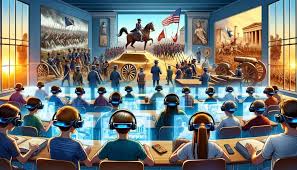Augmented Reality: A New Way to Experience History
AR for Historical Exploration Augmented Experiences for History
Augmented Reality: A New Way to Experience History
Imagine walking through a museum and suddenly seeing ancient Roman soldiers marching before you, or standing in the ruins of an old castle and witnessing the king and queen walking through its halls. This isn't a scene from a movie; it's the power of augmented reality (AR) transforming the way we learn about and interact with history.
AR for Historical Exploration
AR overlays digital information onto the real world, creating immersive and interactive experiences. In the context of history, AR has the potential to revolutionize how we explore and understand the past.
Bringing History to Life
AR can breathe life into historical sites and artifacts. Imagine using your smartphone to scan a Roman coin and see a 3D model of the coin, complete with historical information and audio narration. Or, point your phone at an ancient temple and see a virtual reconstruction of the temple in its original glory.
Interactive Learning
AR makes learning about history more engaging and interactive. For example, students could use AR to explore a virtual battlefield and learn about the strategies and tactics used in a historical battle.
Augmented Experiences for History
AR offers a range of exciting possibilities for enhancing historical experiences:
Virtual Tours
AR can create virtual tours of historical sites, allowing people to explore places they might not be able to visit in person. Imagine taking a virtual tour of the Colosseum in Rome, or walking through the ruins of Pompeii without leaving your living room.
Interactive Museums
AR can transform museums into interactive spaces. Visitors could use AR to explore exhibits, learn about artifacts, and interact with historical figures.
Historical Reconstruction
AR can help us understand the past by allowing us to visualize historical events and objects in a new way. For example, AR could be used to reconstruct a medieval city or to see how a famous painting looked before it was damaged.
Summary:
- AR technology can enhance historical exploration by overlaying digital information onto the real world, creating immersive and interactive experiences.
- AR can breathe life into historical sites and artifacts, making them more engaging for visitors.
- AR offers a range of possibilities for enhancing historical experiences, including virtual tours, interactive museums, and historical reconstruction.
